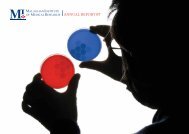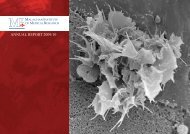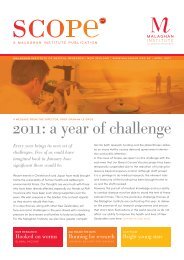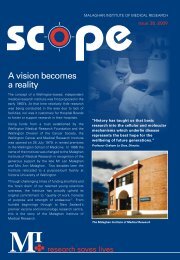Seminars - Malaghan Institute of Medical Research
Seminars - Malaghan Institute of Medical Research
Seminars - Malaghan Institute of Medical Research
Create successful ePaper yourself
Turn your PDF publications into a flip-book with our unique Google optimized e-Paper software.
Asthma and Parasitic<br />
Diseases<br />
Clinical Perspective and Overview <strong>of</strong> Disease Project One: The Basic Biology <strong>of</strong> the Th2<br />
Asthma is a chronic inflammatory disease <strong>of</strong> the airways<br />
in the lungs characterised by periodic attacks <strong>of</strong> wheezing,<br />
shortness <strong>of</strong> breath, chest-tightness, and coughing. It is<br />
<strong>of</strong>ten triggered by harmless environmental stimulants<br />
setting <strong>of</strong>f the part <strong>of</strong> the immune response (termed<br />
the Th2 immune response) that is normally involved in<br />
protecting us against parasitic worms.<br />
New Zealand has one <strong>of</strong> the highest prevalence rates <strong>of</strong><br />
asthma in the world; affecting one in six adults and one in<br />
five children aged 6 to 14. Hospitalisation rates for asthma<br />
sufferers have more than doubled in the past 30 years,<br />
and the condition is conservatively estimated to cost<br />
New Zealand approximately $825 million per year.<br />
Although there are treatments available that reduce<br />
the frequency and severity <strong>of</strong> asthma attacks, there is<br />
currently no cure for this disease.<br />
We hope that by researching the underlying mechanisms<br />
<strong>of</strong> the Th2 immune response that gives rise to asthma,<br />
we will obtain the knowledge and tools necessary for the<br />
design <strong>of</strong> generally applicable vaccines and therapies for<br />
the treatment <strong>of</strong> individuals with established disease.<br />
Response<br />
The cytokine interleukin-4 (IL-4) is thought to be critical<br />
for the development <strong>of</strong> Th2 CD4+ T cells that respond to<br />
parasitic infections and mediate allergic disease. We have<br />
used genetically modified mice whose Th2 cells fluoresce<br />
in a harmless way when they become active to quantify<br />
the IL-4 dependency <strong>of</strong> the Th2 immune response to the<br />
nematode parasite Nippostrongylus brasiliensis.<br />
In 2006 we confirmed that IL-4 and STAT6, previously<br />
thought to be essential for inducing a Th2 immune<br />
response, were not required for Th2 development in our<br />
asthma and allergy models. IL-4 and STAT6 are however<br />
necessary for recruitment <strong>of</strong> inflammatory cells to the<br />
lung. Contrary to recent theories, we also showed that IL-2<br />
and STAT5a signalling does not lead to Th2 induction in vitro.<br />
These data indicate that the differentiation <strong>of</strong> naïve CD4 T<br />
cells to Th2 cells occurs entirely independently <strong>of</strong> IL-4<br />
and STAT6, and that parasite and allergen challenges<br />
induce novel pathways for the selective induction <strong>of</strong> Th2<br />
immune responses.<br />
Group Members<br />
Pr<strong>of</strong> Graham Le Gros, Mali Camberis, Marina Harvie, Melanie<br />
Prout, Dr Debbie Scarlett (to May), Dr Bridget Stocker,<br />
Shiau-Choot Tang, Nicholas van Panhuys







